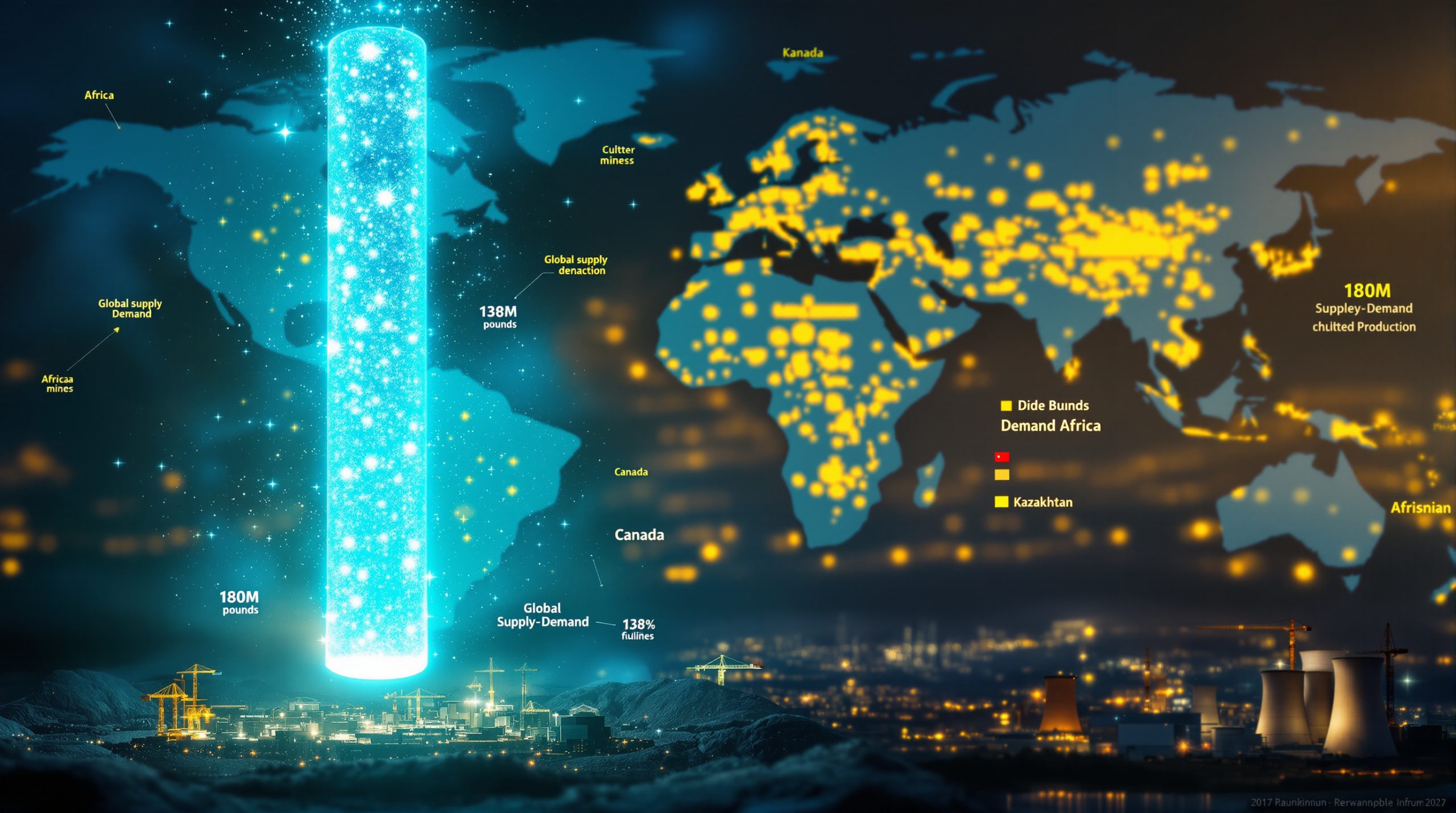Understanding the Uranium Supply Deficit: A Global Energy Challenge
The global uranium market is currently experiencing a significant structural imbalance that continues to widen year after year. Annual reactor demand has reached approximately 180 million pounds, while primary production delivers only about 130 million pounds – creating a substantial 28% shortfall. This represents one of the largest supply-demand gaps in any major energy commodity sector today.
According to the World Nuclear Association, global uranium production was approximately 49,332 tonnes U (129 million pounds U₃O₈) in 2023, while reactor requirements were approximately 65,000 tonnes U (170 million pounds U₃O₈). This deficit isn't merely a temporary phenomenon but the result of a decade-long market imbalance that has accelerated in recent years.
The gap between uranium consumption and production is projected to expand further as nuclear power development accelerates globally. Conservative estimates suggest cumulative shortfalls could reach 300-350 million pounds through 2040, requiring significant inventory drawdown and secondary sources to fill the gap.
Historical Context: What Caused the Current Uranium Supply Shortage?
Post-Fukushima Market Depression
The 2011 Fukushima disaster triggered a prolonged period of depressed uranium prices, with spot values falling from over $70/lb to under $20/lb by 2016, bottoming out at approximately $18/lb in 2017. This price collapse created a devastating chain reaction throughout the uranium supply chain:
- Mine Closures and Care & Maintenance: Major producers shuttered mines or placed them on standby, including McArthur River in Canada, widely considered the world's largest high-grade uranium mine
- Project Abandonment: Numerous development-stage projects were shelved indefinitely as economics became untenable
- Exploration Collapse: Investment in new uranium discoveries virtually disappeared, creating a future supply gap
- Corporate Consolidation: The industry contracted dramatically, with many junior miners exiting the space entirely
This multi-year period of underinvestment created a supply base incapable of responding quickly to renewed demand, laying the groundwork for today's uranium supply deficit.
Geographic Concentration of Production
The uranium supply chain suffers from extreme concentration risk that makes it vulnerable to disruptions:
- Five countries account for approximately 88% of global uranium production
- Kazakhstan alone represents 43% of worldwide output
- Many Western utilities became heavily dependent on material from regions with significant geopolitical risk
This concentration has created vulnerability to supply disruptions, as demonstrated by recent events in Kazakhstan (civil unrest in 2022) and Niger (military coup in 2023 that disrupted operations of French mining company Orano).
Permitting and Development Challenges
New uranium projects face extraordinary hurdles compared to other mineral commodities:
- Lengthy Permitting Timelines: Even in mining-friendly jurisdictions, uranium projects typically require 7-10 years from discovery to production
- Technical Complexity: High-grade deposits often require specialized mining techniques and safety protocols
- Capital Intensity: Modern uranium mines can require $500 million to over $1 billion in development capital
- Regulatory Scrutiny: Nuclear fuel chain oversight has intensified globally following high-profile incidents
These factors combine to create significant inelasticity in uranium supply response, meaning that even at higher prices, new production takes years to materialize.
The Production Challenge: Why Can't Producers Simply Increase Output?
The Time Factor in Uranium Mining
The uranium industry faces unique constraints that prevent rapid supply response:
- Restart Timelines: Existing mines in care and maintenance require 18-24 months to resume meaningful production
- Workforce Challenges: Specialized mining expertise has dissipated during the downturn, creating labour shortages
- Supply Chain Issues: Equipment and material shortages affect mine development timelines
- Regulatory Approvals: Restarting operations often requires updated permits and environmental assessments
Major producers like Cameco and Kazatomprom have emphasized that production decisions require long-term price signals, not short-term spot market movements. This disciplined approach has prevented the usual boom-bust cycles seen in other commodity markets.
Economic Thresholds for New Production
The economics of uranium mining have fundamentally changed since the last cycle:
- Rising Production Costs: Inflation has pushed breakeven costs for many Western producers to $75-90/lb
- Capital Return Requirements: Investors now demand higher returns on mining investments after years of losses
- Financing Hurdles: Project financing requires demonstrated long-term price stability
- Contract Structure Shifts: Producers increasingly seek market-related contracts with price floors around $70/lb and ceilings above $130/lb
These factors mean that even at current price levels (low $80s/lb), many projects remain economically challenging without sustained higher prices or innovative financing structures.
Utility Perspective: How Are Nuclear Operators Responding?
The Contracting Crisis
Nuclear utilities face unprecedented procurement challenges:
- Coverage Gaps: Approximately 25-30% of 2025 uranium requirements remain uncontracted
- Worsening Exposure: Uncovered needs rise to 35-40% for 2026 and nearly 70% by 2027-2028
- Inventory Depletion: Post-Fukushima stockpiles have largely been consumed
- Conversion and Enrichment Pressures: The entire nuclear fuel cycle faces similar constraints
This represents the largest contracting deficit in three decades, creating significant supply security concerns for power generators who typically maintain years of forward coverage.
Evolving Procurement Strategies
Utilities are adapting their approaches in several ways:
- Longer Contract Terms: Moving from typical 3-5 year agreements to 7-10 year commitments
- Higher Price Acceptance: Recognizing the need for prices that support production economics
- Diversification: Reducing dependence on any single geographic region
- Inventory Building: Some utilities are rebuilding strategic stockpiles
- Direct Investment: Several utilities have taken equity stakes in uranium developers
These shifts represent a fundamental change in the buyer-seller dynamic that has prevailed since Fukushima. Utilities have also been distracted by more immediate concerns in recent years – from operational challenges during COVID-19 to the massive US market disruption following Russia's invasion of Ukraine.
Demand Growth: What Additional Factors Are Emerging?
The Nuclear Renaissance Accelerates
The global outlook for nuclear energy has transformed dramatically in recent years:
- New Reactor Construction: Over 60 large-scale reactors are currently under construction globally according to the IAEA
- Life Extensions: Many existing reactors are being relicensed for 60-80 year operational lifespans
- China's Nuclear Expansion: Plans for 150+ new reactors by 2060, requiring massive uranium supplies
- SMR Development: Small modular reactor deployments could add significant incremental demand
Each 1,000 MW reactor requires approximately 400,000-500,000 pounds of uranium annually, meaning even modest nuclear growth creates substantial additional demand. China alone faces a projected 70 million pound uranium shortfall through 2030 when comparing their reactor consumption to domestic production plus their ownership stakes abroad.
Technology and Industrial Applications
Emerging uses for nuclear power are creating new demand vectors beyond traditional power generation:
- Data Center Power: Major technology companies exploring nuclear options for AI and cloud infrastructure, with analysts projecting 60 gigawatts of new capacity needed for AI alone by 2030
- Hydrogen Production: Nuclear-powered hydrogen production becoming economically viable
- Industrial Heat: High-temperature reactors for industrial processes
- Desalination: Nuclear-powered water purification in water-stressed regions
These applications represent potential demand growth beyond traditional electricity generation and could accelerate uranium consumption beyond current projections.
Market Response: How Are Prices and Investors Reacting?
Price Dynamics and Market Signals
Uranium prices have responded to the supply-demand imbalance with significant uranium market volatility:
- Spot Price Recovery: From cycle lows of $18/lb to recent levels above $80/lb, with a brief peak at $107/lb in 2023
- Term Price Divergence: Long-term contract prices increasingly diverge from spot markets
- Volatility Increase: Price movements have become more pronounced and frequent
- Physical Sequestration: Investment vehicles like the Sprott Physical Uranium Trust have removed significant material from circulation
These price signals are essential for incentivizing new production, but the lag between price increases and supply response remains substantial. The market has shown that when prices approach $100/lb, inventory holders become willing sellers, creating temporary resistance levels.
Investment and Production Discipline
The industry has demonstrated unusual restraint in responding to higher prices:
- Measured Restarts: Major producers have avoided flooding the market with new supply
- Strategic Acquisitions: Consolidation of high-quality assets rather than aggressive development
- Capital Allocation Prudence: Focus on margin over volume
- Long-Term Contracting: Emphasis on securing favorable long-term agreements before committing to expansion
This discipline has prevented the boom-bust cycles that have historically plagued commodity markets and suggests producers have learned from past mistakes.
Future Supply: What Projects Could Address the Gap?
Canadian Basin Development
Several advanced projects in Canada's Athabasca Basin could meaningfully impact supply:
- NextGen's Arrow Deposit: Potentially 25+ million pounds annually at full production, with measured and indicated resources approaching a quarter billion pounds
- Denison's Phoenix Deposit: In-situ recovery project with low environmental footprint, targeting potential production by 2028
- Fission's Triple R Project: High-grade deposit now owned by Paladin Energy with development potential
However, these projects face significant permitting hurdles, with final regulatory decisions expected in 2025-2026 that will determine their development timelines. The complex nature of these high-grade deposits means that even after permitting, several years of development work would be required.
African Expansion Potential
Africa represents a significant source of potential supply growth:
- Namibian Projects: Existing operations with expansion potential, though the recent Namibian uranium mining halt by Paladin Energy demonstrates ongoing challenges
- Niger Developments: Political stability will determine future production following the 2023 coup
- Botswana Exploration: Emerging uranium frontier with several promising projects
These jurisdictions generally offer faster permitting timelines but face other challenges including infrastructure constraints and political considerations. Global Atomic's Dasa project in Niger remains a key development to watch, with significant financing hurdles following the country's political turmoil.
Australian Regulatory Evolution
Australia holds approximately 28% of the world's uranium resources but faces regulatory restrictions:
- State-Level Bans: Several Australian states maintain uranium mining prohibitions
- Policy Reconsideration: Growing pressure to review these restrictions
- Development Pipeline: Multiple advanced projects awaiting regulatory clarity
Any significant policy shifts could eventually bring several million pounds of annual production online, though development timelines would still extend 4-6 years from approval. However, even with policy changes, these projects would likely replace depleting mines rather than create an oversupply situation.
Strategic Implications: What Are the Long-Term Effects?
National Security Considerations
The uranium supply deficit has elevated nuclear fuel security as a national priority:
- Strategic Reserves: Several countries establishing uranium stockpiles
- Domestic Production Incentives: Government support for local mining
- Fuel Cycle Investments: Renewed focus on conversion and enrichment capacity
- Supply Chain Diversification: Reducing dependence on any single source region
These initiatives reflect recognition that nuclear fuel security is fundamental to energy independence and climate goals. The passage of legislation introducing a US ban on Russian uranium imports by January 1, 2028, further demonstrates the geopolitical dimensions of the uranium market.
Market Structure Evolution
The uranium market itself is evolving in response to the deficit:
- Contract Structure Changes: Market-related pricing with floors and ceilings becoming standard
- Increased Transparency: Greater reporting of contract terms and conditions
- New Market Participants: Additional trading firms and financial institutions entering the space, including Mercuria
- Liquidity Improvements: Higher transaction volumes and more sophisticated trading mechanisms
These changes represent the market's adaptation to a fundamentally different supply-demand dynamic. Price reporting services are struggling to adapt to the shift from fixed-price to market-related contracts, potentially understating the true economics of new agreements.
The Path Forward: Navigating the Uranium Deficit
The uranium supply deficit represents a structural challenge that will require years to resolve. Even with higher prices, the combination of depleting mines, development timelines, and accelerating demand creates a persistent gap that cannot be quickly addressed.
For the market to rebalance, several conditions must be met:
- Sustained Higher Prices: Price levels that support both existing and new production
- Regulatory Clarity: Clear permitting pathways for development projects
- Capital Deployment: Significant investment in new production capacity
- Supply Chain Development: Rebuilding the specialized expertise and infrastructure
Until these conditions align, the uranium market will likely remain in deficit, with implications for nuclear utilities, energy security, and the broader clean energy transition. The market would need to see a significant negative demand event – such as a major shift away from nuclear power – to experience lower prices in five years than today's levels.
For investors and market participants, understanding the structural nature of this deficit and the long lead times required for new production is crucial. Furthermore, the advancement of US uranium production tech will play a critical role in addressing domestic supply concerns. The uranium market's recovery isn't just a typical commodity cycle but represents a fundamental realignment of an industry essential to global decarbonization efforts.
Want to Invest in the Next Major Uranium Discovery?
Discover promising ASX uranium exploration companies before they make headlines with Discovery Alert's proprietary Discovery IQ model, which transforms complex mineral data into actionable investment insights. Explore our dedicated discoveries page to understand how major uranium discoveries can lead to exceptional market returns and position yourself ahead of other investors.




